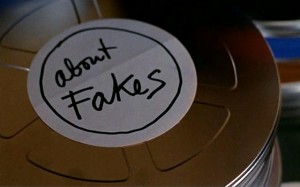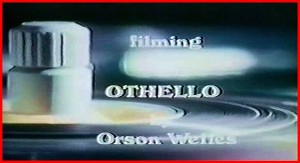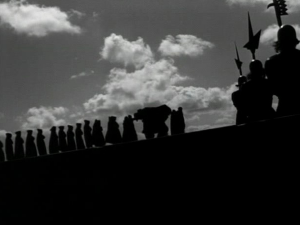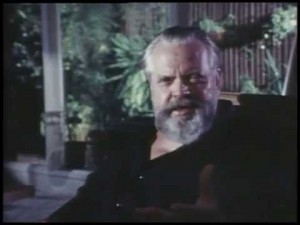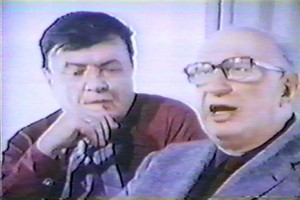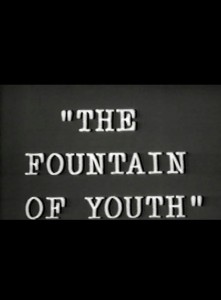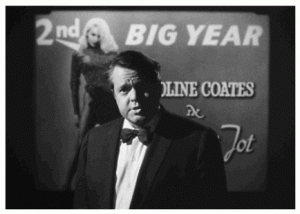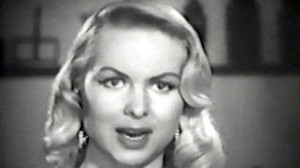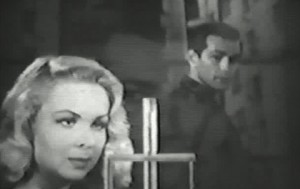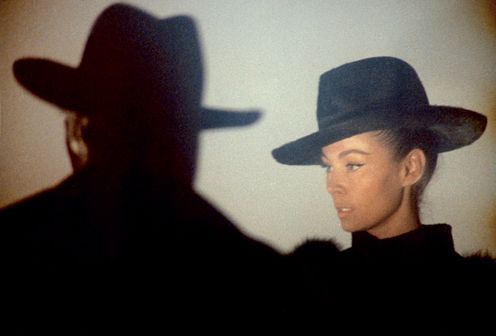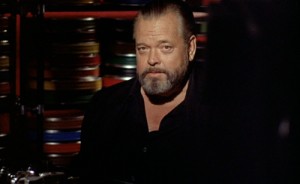From Cinematograph, vol. 4, 1991; reprinted in both Placing Movies: The Practice of Film Criticism and Discovering Orson Welles. — J.R.
I want to give the audience a hint of a scene. No more than that. Give them too much and they won’t contribute anything themselves. Give them just a suggestion and you get them working with you. That’s what gives the theatre meaning: when it becomes a social act.
— Orson Welles, quoted in Collier’s, 29 January 1938
Two propositions:
1. One of the most progressive forms of cinema is the film in which fiction and nonfiction merge, trade places, become interchangeable.
2. One of the most reactionary forms of cinema is the film in which fiction and nonfiction merge, trade places, become interchangeable.
How can both of these statements be true — as, in fact, I believe they are? In the final analysis, the issue is an ethical one. In support of 2, there are docudramas that use spurious means to grant bogus authenticity to fiction (MISSISSIPPI BURNING is a good example), and documentaries that employ fictional devices in order to lie more effectively (e.g., the studio retakes in Leni Riefenstahl’s TRIUMPH OF THE WILL, which are well documented in Albert Speer’s Inside the Third Reich).
In support of 1, there are masterpieces collapsing, combining, and/or juxtaposing fiction and nonfiction in order to facilitate and broaden a filmmaker’s grasp on a subject in the interests of truth. This is a highly subjective matter, of course, but a few of my own key touchstones in this category would be:
1. Josef von Sternberg’s THE SAGA OF ANATAHAN (1953)
2. Alain Resnais and Marguerite Duras’s HIROSHIMA, MON AMOUR (1959)
3. Jean-Marie Straub and Danièle Huillet’s THE BRIDEGROOM, THE COMEDIENNE, AND THE PIMP (1968)
4. Jacques Rivette’s OUT 1: NOLI ME TANGERE (1971)
5. Orson Welles’s F FOR FAKE (1973)
6. Jacques Tati’s PARADE (1973)
7. Jean-Luc Godard’s ICI ET AILLEURS (1974)
8. Chris Marker’s SANS SOLEIL (1982)
9. Françoise Romand’s MIX-UP (1985)
10. Râúl Ruiz’s MAMMAME (1987)
11. Joris Ivens and Marceline Loridan’s A TALE OF THE WIND (1988)
12. Leslie Thornton’s PEGGY AND FRED IN HELL (still in progress)
***
Two propositions:
1. All of Orson Welles’s film and television work can be divided into two categories, fiction and nonfiction.
2. All of Orson Welles’s film and television work can be divided into two categories, stories and essays.
This leads us into certain semantic problems from the outset: stories, after all, can be fictional or nonfictional, and essays can make use of fiction as well as nonfiction. Then there is the equally vexing question of how we define a “work” by Orson Welles, which has been addressed in some detail by James Naremore (1): if we include only works that were both completed and publicly shown, we narrow our scope considerably, but if we decide to broaden our list, we invariably come up with a different set of problems.
Let us try to make do with four separate lists, all of them necessarily somewhat tentative and incomplete, none of which includes the (now lost) films done by Welles as interludes in many of his stage productions, but still comprising two dozen works in all:
(a) nonfiction or essay films by Welles that were completed and shown:
CITIZEN KANE (trailer, circa 1940)
THE ORSON WELLES SKETCHBOOK (BBC-TV, 1955, six 15-minute programs)
AROUND THE WORLD WITH ORSON WELLES (ITA-TV, 1955, six 26-minute programs)
NELLA TERRA DI DON CHISIOTTE (IN THE LAND OF DON QUIXOTE ) (RAI, 1964, nine 30-minute programs)
F FOR FAKE (film, 1973)
FILMING OTHELLO (film, 1978)
(b) nonfiction or essay films by Welles that were completed but not publicly shown:
condensed first act of Wilde’s The Importance of Being Earnest and last scene of Shakespeare’s Henry IV (filmed record of performance in Munich, 1950)
ORSON WELLES AND PEOPLE (independently produced television pilot about the life of Alexandre Dumas, 27 minutes, circa 1956)
PORTRAIT OF GINA (ABC, 1958)
SPYING IN VIENNA (sketch done for unshown CBS television special, Orson’s Bag, 1969)
F FOR FAKE (trailer, 1976, 9 minutes)
(c) nonfiction or essay films that were started but not completed:
IT’S ALL TRUE (film, 1942)
MOBY DICK—REHEARSED (film record of London stage performance, 1955)
THE DOMINICI AFFAIR (program for Around the World with Orson Welles television series, 1955)
THE MAGIC SHOW (film record of magic performance without camera tricks, 1969–1985)
FILMING THE TRIAL (film, circa early 1980s)
(d) fiction films of Orson Welles that utilize documentary, pseudodocumentary, or essayistic elements:
CITIZEN KANE (1941; pseudodocumentary News on the March segment)
THE MAGNIFICENT AMBERSONS (1942; essayistic narration)
THE STRANGER (1946; documentary footage of concentration camps)
MR. ARKADIN (1955; pseudodocumentary prologue)
DON QUIXOTE (1955–1985, unfinished; essayistic narration) THE
FOUNTAIN OF YOUTH (television pilot, 1956; essayistic narration)
CHIMES AT MIDNIGHT (1966; essayistic narration from Holinshed’s Chronicles)
THE OTHER SIDE OF THE WIND (1970-?, unfinished; pseudodocumentary form throughout)
***
The process-oriented methods that permitted at least four Welles features and a number of short works to be left unfinished are easier to understand than they would be if we adopted the mental habits of producers, which is exactly what more and more critics today seem to be doing; but that is no comfort to those of us eager to understand, and eager as critics always are to have the last word, which we are not about to have with this filmmaker. At least our direction, as always, is laid out for us: as long as one frame of film by the greatest filmmaker of the modern era is moldering in vaults, our work is not done. It is the last challenge, and the biggest joke, of an oeuvre that has always had more designs on us than we could ever have on it.
— Bill Krohn, Cahiers du Cinéma, 1986 (2)
Any investigative foray into the legacy of Welles that is undertaken today, including this one, has to be at once historical research and an exercise in science fiction. With a substantial part of Welles’s work still unavailable to us, each “new” work has to serve double duty as a fresh chapter in his tangled oeuvre and as an additional skeleton key for unlocking some of the mysteries in his other works, visible and invisible alike. In the case of FILMING OTHELLO — the last feature of his to have been completed and shown publicly before his death in 1985—we have an additional complication of confronting an extended meditation on an earlier Welles feature that is currently unavailable in the United States (although this situation may change in the near future: Welles’s youngest daughter Beatrice, who has inherited the American rights to OTHELLO, is currently planning to rerelease the film, and, as I write, Michael Dawson is in the process of restoring the film for this purpose). But while this meditation of FILMING OTHELLO is clearly no substitute for the 1952 OTHELLO it describes, it is a fascinating enough essay in its own right.
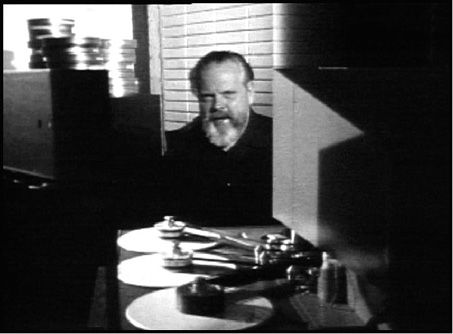
FILMING OTHELLO was planned as the first in a series of films in which Welles would reexamine some of his earlier works; the second in the series, which he had already started (again, with cinematographer Gary Graver), was devoted to THE TRIAL. Why did he choose these films rather than, say, CITIZEN KANE or TOUCH OF EVIL? Partially, it seems, because these were the two of his released features on which he had final cut which were most governed by chance and the financial vicissitudes which required last-minute changes and improvisations. Indeed, both films were initially designed to be shot in studios and then had to be completely redesigned in relation to found locations once the initial financing evaporated. And both films outline the radical change in Welles’s aesthetics that accompanied this readjustment — the realization that if he wanted to make films his own way, as he had once before been able to do only on KANE , he would have to do them differently.
OTHELLO, in particular, inaugurates the whole “second manner” of Welles’s film career, which might be called the bricolage or caméra-stylo manner (in contrast to the studio shooting that dominates nearly all of his 1940s work) — a manner that persists with only a few exceptions (i.e., TOUCH OF EVIL ) to the end of his life. Because Welles found himself periodically running out of money during the shooting of OTHELLO — obliging him to go off and act in commercial films in order to raise the money to continue — he found himself adopting a number of new strategies in order to make his stop-and-start procedures more viable. Some of the major characteristics of his second manner include the spirit of bricolage (the most famous instance in OTHELLO being the restaging of the killing of Roderigo in a Turkish bath after the costumes for the scene failed to show up), the increasing importance of editing over camera movement (largely due to the loss of such studio equipment as tracks and cranes), the increasing use of doubles (for actors and locations alike), a certain loss in sound depth, and Welles’s growing tendency to dub other actors’ voices himself — all characteristics that tended to increase the spatial disorientation of the viewer and minimize the long takes of Welles’s earlier work.
Conceivably the most modest of all the films in the Wellesian canon (unless one counts the nine-part television series IN THE LAND OF DON QUIXOTE done for RAI in 1964, a conventional and relatively uninteresting “home movie” travelogue), in budget as well as aspiration, FILMING OTHELLO can itself be read as a kind of shotgun marriage between chance and control. In contrast to both Welles’s carefully composed monologues beside a movieola and an impromptu question-and-answer session in Boston is the “dialogue” with Michael Mac Liammóir and Hilton Edwards over lunch which forcibly combines these modes: on the one hand, three colleagues ruminating about Shakespeare’s play around a table; on the other, isolated and carefully composed shots of a conversing Welles seated at another table — clearly inserted later, though with no attempt to disguise the mismatches of sound as well as image. (Earlier examples of this doggedly “unprofessional” technique can be found in the 1958 television film PORTRAIT OF GINA, cited above — a rambling personal essay about Gina Lollobrigida and pin-ups in Italy which was made for and rejected by CBS in 1958, and which is conceivably as full of digressions as this parenthesis. The checkered history of this particular film maudit, moreover, has plenty of mismatched discontinuities of its own: almost eighteen years after Welles left it behind in his hotel room in Paris, it was rediscovered by chance in a storage area in the mid-1980s; after a lengthy excerpt was shown on French television — the only portion I’ve been able to see — the film was screened in its entirety at the Venice Film Festival before promptly vanishing again, reportedly due to legal objections from Lollobrigida.) According to Gary Graver, these mismatches can partially be explained by the fact that several years passed between the lunch with Mac Liammóir and Edwards and the inserted shots of Welles, and the film stock that was used for the former was no longer being made when Welles came to shoot the latter. Even here, however, the apparent dialectic between an impromptu documentary method and a more “composed” form of discourse is not as clear-cut as it may first appear: Welles’s allusion at one point during the lunch to a woman’s remark made between takes foregrounds that this “documentary” is far from random, while the gist of his inserted remarks blends smoothly with the logical flow of the discussion.
If many of Welles’s late films gravitate toward the essay film (“The essay does not date,” he remarked in a 1982 interview, “because it represents the author’s contribution, however modest, to the moment at which it was made.”), it should be kept in mind that the forms of essay and documentary are inscribed in his fictional work from the beginning, even before he turned to movies. (The news bulletins in his famous 1938 War of the Worlds radio broadcast are the most obvious example, but a careful examination of his other work in radio and theater during the 1930s would surely turn up others.) More specifically, it is the ambiguous merging of fact and fiction which engages Welles the most — providing the basic principle behind his DON QUIXOTE (to judge at least from the forty-five minutes or so that I’ve seen, which plant Cervantes’s fictional characters in a documentary version of contemporary Spain), becoming the very subject of F FOR FAKE , and actually forming more of the texture of FILMING OTHELLO than Welles’s candor as a monologuist might at first suggest. For most of what we see of OTHELLO in FILMING OTHELLO is not excerpts preserved intact but an intricate re-editing of the original material — the scrambled shards of a dream of OTHELLO, oddly akin to the dreamlike prologue of KANE, rather than the film itself. Apart from the precredits funeral sequence that opens OTHELLO and FILMING OTHELLO alike, the footage is re-edited and shown silent over Welles’s 1978 commentary, giving a complex and ironic twist to Welles’s remarks about “quoting or misquoting” critical comments by Jack Jorgens and André Bazin about OTHELLO.
Creatively misquoting his own film at the same time that he misquotes his critics, Welles thus continues his projects of candid concealment and continuous revision which have already made his filmmaking career as labyrinthine and as mysterious as it is. And transposing some of the same giddy continuity of OTHELLO whereby Iago crosses continents “in the middle of a spoken phrase” and the separate thrusts in a skirmish between Roderigo and Cassio occur a thousand miles apart, Welles reshuffles and reorders much of the material in his own commentary, and revises the performances of himself and Mac Liammóir by reciting some of the same speeches—performing a creative dance around an object that is never allowed to remain fixed and static. Such work-in-progress, with both the subject and the object of the discussion in a perpetual state of becoming, seems only fitting as a contribution to an oeuvre which, as Bill Krohn points out above, refuses to allow us the last word, even while it actively and generously invites our participation.
***
The position of power enjoyed by the storyteller/essayist/narrator in much of Welles’s work is more than a simple or seamless technique; considering the multiple and complex changes that are wrung from this position, it deserves to be treated as a preoccupation of the work itself, a notion of media as mirror whereby the performer paradoxically becomes the spectator of himself, the drama at hand providing the individual lens for his latest exercise in self – scrutiny. It is a narcissism always mediated and/or contested by a moral inquiry: HEART OF DARKNESS , Welles’s first Hollywood project, revolved around the notion of playing both Marlow (off-screen narrator and first-person camera) and Kurtz (on-screen demagogue/villain) — that is, witness as well as subject. (3) From KANE through TOUCH OF EVIL, the Welles character that we see on screen is never as moral (virtuous or truthful) as the Welles persona who might be telling the story off-screen — even if, as in THE LADY FROM SHANGHAI , the Welles character is narrating his own story (and thereby registers as a sadder and wiser version of the Michael O’Hara that we see). (4)
In THE FOUNTAIN OF YOUTH , Welles’s first television pilot — an adaptation of John Collier’s short story “Youth from Vienna” that begins as an essay on the subject of narcissism — the dialectic is given a new pattern. For once, the narrating Welles persona is intermittently visible as well as audible; he begins the show, in effect, as a slide show lecturer, and reappears periodically to remind us of his privileged position. But as he basks in both his fictive power to give his static slides motion and his essayistic authority to freeze his characters again in order to digress about Narcissus or Ponce de Leon, the visibility of his manipulation undermines certain aspects of his narrative authority, turning his fiction into a documentary about himself (much as FILMING OTHELLO begins as a documentary about the actual OTHELLO, and partially winds up as a documentary about a re-edited, hence fictional, OTHELLO ). By speaking for the characters as well as about them — literally lip-synching Joi Lansing, Dan Tobin, and Rick Jason, his three stars, at certain junctures to mock their role as puppets — his moral fallibility (that is to say, his narcissism) becomes identified with theirs, and the implicit nastiness of Welles’s amused, glacial detachment consciously boomerangs.
It seems fairly likely that ORSON WELLES AND PEOPLE — Welles’s second unsold television pilot, made after THE FOUNTAIN OF YOUTH and before TOUCH OF EVIL — is a lost work that will never be recovered. According to Fletcher Markle, a good friend of Welles during this period who is one of the few people to have seen it, it was a pilot about the Dumas family, done for a half-hour biographical series that would in theory eventually include such disparate figures as Winston Churchill and P. T. Barnum; Welles financed it himself on a minuscule budget, using the $5,000 he had been paid for appearing (paradoxically, as himself) and performing part of a magic act on I Love Lucy, and the entire thing was shot in a single day, in “a cheap, non-union 16mm studio — a converted garage, as I recall, somewhere off Hollywood Boulevard,” with Welles as narrator, armed with “masses of period photos and drawings of Dumas and the Paris of his day” that were “blown up for use on the insert stand.” (5) One imagines that it might have been a somewhat elaborated version of the simple talking-head format of THE ORSON WELLES SKETCHBOOK , a British television series done a year or so earlier, just as IN THE LAND OF DON QUIXOTE can be regarded as a close cousin of the British television series AROUND THE WORLD WITH ORSON WELLES (to judge from the single episode I’ve seen in the latter — a chat with Kenneth Tynan about bullfighting, shot in Spain). Like PORTRAIT OF GINA, it seems likely that most or all of these television works, with the striking exception of THE FOUNTAIN OF YOUTH, qualify as ephemera, but they are significant insofar as they represent the seeds or offshoots of more important works — much as the methodology of F FOR FAKE can already be seen in embryo in PORTRAIT OF GINA , for instance.
***
The two major documentary forays of Welles on film, standing roughly at opposite ends of his film career, are IT’S ALL TRUE (1942) and F FOR FAKE (1973), two projects whose very titles together express a dialectical relationship to the documentary. The first of these, which occasioned the disastrous turning-point in Welles’s Hollywood career away from creative control and studio support, was in some respects as ambitious as CITIZEN KANE and THE MAGNIFICENT AMBERSONS in its conception. But for many years, some of the facts about this work have been repeatedly misrepresented in books about Welles, so a brief description of the project is in order.
Originally planned at RKO as a collection of sketches on diverse North American subjects — including a history of jazz, a love story about Italian immigrants, and a Robert Flaherty tale about the friendship between a Mexican boy and a bull — IT’S ALL TRUE quickly turned into a film about Latin America when Nelson Rockefeller, Coordinator of the Office of Inter-American Affairs and RKO board member, appointed Welles as Good Will Ambassador to Brazil in late 1941. Welles was encouraged to speed up the production of both THE MAGNIFICENT AMBERSONS and JOURNEY INTO FEAR SO that he could arrive in Rio in time to shoot the Carnival for a history of the samba. The Mexico episode, which Norman Foster had already started shooting in September 1941, was temporarily suspended so that Foster could direct JOURNEY INTO FEAR , and Welles was assured by RKO that he could complete the editing of AMBERSONS in Rio. Welles also planned episodes about the conquest of Peru and another Brazilian episode re-creating the journey of four Northeastern fishermen, or jangadeiros, on a raft from Fortaleza to Rio (over 1,500 miles) to petition the Brazilian president for social benefits. All four episodes seem to have been conceived somewhat after Flaherty’s documentary methods — that is, a mixture of genuine documentary with re-creations. Unfortunately, RKO failed to honor its promises about AMBERSONS (Welles was not able to do the final cutting), and the leader of the jangadeiros accidentally drowned during the re-creation of their journey to Rio. RKO had meanwhile gone through a massive reorganization during Welles’s absence, and the film was abruptly called off and shelved after Welles had shot a great deal of footage. (Welles made many subsequent unsuccessful efforts to buy back the footage and complete the film after his return to the United States.)
Paradoxically, it wasn’t until many years after the release of F FOR FAKE that enough information about IT’S ALL TRUE came to light to make a limited critical assessment of this project possible. This information came in two parts. First came the discovery in the mid-1980s of about two-thirds of the unedited material shot by Welles in Fortaleza at the very end of his Brazilian sojourn, with a silent Mitchell camera and a skeleton crew of five (cameraman George Fanto and his assistant Reginaldo Calmon, Richard and Elizabeth Wilson, and Shifra Haran) — material which possibly represents the most ambitious footage shot by Welles in Brazil, most of which had never been seen (even by Welles) or even processed prior to its relatively recent discovery. (Samples of this footage are visible in Richard Wilson’s 1986 short FOUR MEN ON A RAFT , which he is still hoping to expand into a feature.) Then came the revelatory research carried out in both Brazil and the United States by Robert Stam and others (6) — research which is still in progress, but which has already yielded some fascinating discoveries. Drawing on an array of Hollywood and Brazilian documents, including the research conducted and commissioned by Welles at the time, Stam persuasively argues, for instance, that most of the complaints about Welles’s profligacy in Brazil can be attributed to his radical problack stance, including the fact that he enjoyed the company and collaboration of blacks, as well as his insistence on featuring nonwhites as the central characters in both of the film’s Brazilian episodes. Based on this reading, which Stam explores in detail, one is encouraged by Stam to reread most disapproving biographical accounts of Welles’s “Brazilian episode,” especially those of Charles Higham and John Russell Taylor, as unconsciously but unmistakably racist. (It should be noted, incidentally, that the style of photography in the Fortaleza rushes bears certain relationships to the visual styles and rhetoric of both Flaherty and Dovzhenko; variations in this style can be found in both OTHELLO — also shot by Fanto — and certain passages in DON QUIXOTE.)
Certainly the ideological issues raised by Welles’s encounters with Hollywood are rich in unexplored subtexts, from the relatively recent canonization of CITIZEN KANE as a safe Hollywood classic to the widespread hostility expressed by American critics toward Welles for the remainder of his life because he failed to match up to industry standards, yielding him a “failure” after KANE in the eyes of the middlebrow press. (7) If the progressive lucidity of Stam’s research, converting fiction into fact, helps to clarify to what degree the radical political thrust of Welles’s work as a whole — on radio and in theater as well as in film — has been either ignored or actively concealed by most Welles research, it is worth examining briefly another kind of routine obfuscation in academic film studies that has helped along some of the same process: converting fact into fiction.
It is almost an axiom in contemporary academic film theory that the fewer films one has seen or knows about, the better and clearer the academic mind is in following its own theoretical bents. As a French cinéphile, Gilles Deleuze is rather atypical in this respect, as the numerous film titles cited in both Cinéma 1: L’image-mouvement and Cinéma 2: L’image-temps demonstrate. Although he is not always meticulous, he at least gives some evidence that he usually knows something about what he is discussing. This is less true, alas, of many of his readers, including the English translators of Cinéma 2: L’image-temps, and thanks to the weird collusion of Deleuze, his proofreaders, the aforementioned translators, and their proofreaders, Cinéma 2: The Time-Image (University of Minnesota Press, 1989) offers detailed commentary on a good many nonexistent films — a Borgesian bounty that inadvertently echoes all the fake masterpieces that are created, exhibited, and discussed in F FOR FAKE.
Among the many intriguing items found in the index are Mankiewicz’s THE BLOODHOUND, Minnelli’s THE PERFECT WIFE, Donen’s PAJAMA PICNIC, Ophüls’s HOUSE OF PLEASURE, Murnau’s THE LAST MAN (not to be confused with THE LAST LAUGH, which is listed separately), Straub’s RESISTENZA, a CABINET OF DR. CALIGARI directed by Fritz Lang (which also crops up in Peter Gidal’s recent Materialist Film, giving it further credence), and even a Marguerite Duras Western (DESTRY SHE SAID ).
In the case of Welles, this has the rather grotesque consequence of collapsing IT’S ALL TRUE and F FOR FAKE into the same film (although, to complicate matters further, they are listed separately in the index). The French title of F FOR FAKE is VERITÉS ET MENSONGES ; Deleuze — who is, after all, only a film theorist — calls it VERITÉS ET ILLUSIONS; and his translators, apparently finding at least half of both titles problematical, solve this difficulty by calling it IT’S ALL TRUE. (They have also faithfully preserved all of the misspellings and typos in the French edition, so that two of Welles’s leading costars in F FOR FAKE — Elmyr de Hory and Oja Kodar — are now Elmer and Kadar.)
Collapsing the distinctions between truth and fiction in more ways than one, Deleuze’s semigibberish text in English about Welles in The Time-Image, mixing titles, mauling names, and inverting the order of sequences in F FOR FAKE , creates a mad, tantalizing weave that is positively Wellesian (the bracketed comments in italics are my own):
. . . a becoming, an irreducible multiplicity, characters or forms are now valid only as transformations of each other. And this is the diabolical trio of THE LADY FROM SHANGHAI, the strange relay-characters of Mr. Arkadin [sic ], the chain which unites those in TOUCH OF EVIL, the unlimited transformation of those in THE TRIAL, the journey of the false which constantly passes through the king, his son, and Falstaff, all three imposters and usurpers in some way, culminating in the scene where the roles are exchanged. It is finally the great series of IT’S ALL TRUE, which is the manifesto for all of Welles’s work, and his reflection on cinema. F for Falstaff, but above all F for fake.
.. . . the great series of Welles, the story that is continually being modified, may be summed up as follows:
1. “presentation of Oja Kadar, whom all men turn to look at in the street”;
2. “presentation of Welles as conjuror” [Deleuze has inverted the order of sequences here ];
3. presentation of the journalist, author of a book about a forger of paintings, but also of false memoirs of Hughes, the millionaire forger with a multiplicity of doubles, whom we do not know if he has himself harmed the journalist [why no more inverted commas, and why no more coherent syntax? ];
4. conversation or exchange between the journalist and the forger of paintings;
5. intervention of Welles who assures that, for an hour, the viewer will neither see nor hear anything else false [again, out of sequence ];
6. Welles recounts his life, and reflects on man in front of Chartres Cathedral;
7. Oja Kadar’s affair with Picasso at the end of which Welles arrives to say that the hour has passed and the affair was invented in every respect;
8. Welles wishes his audience a good evening.
***
F FOR FAKE remains one of Welles’s most controversial works insofar as for many spectators, including some Welles enthusiasts, it is not really a “Welles film” at all. (To clarify Deleuze’s garbled description a little, the film, visibly narrated by Welles in a manner that suggests at times both THE FOUNTAIN OF YOUTH and FILMING OTHELLO, is mainly concerned with art forger Elmyr de Hory, Clifford Irving — who wrote a book about de Hory called Fake before be successfully forged Howard Hughes’s autobiography — and diverse elements of fakery in Welles’s own past, such as his War of the Worlds broadcast and his own entry into professional acting in Dublin . . . not counting several hoaxes and digressions of its own.)
There has even, ironically enough, been some confusion regarding the authorship of F FOR FAKE, as there has been with FILMING OTHELLO (occasioning, in the case of the latter film, one of the few gaffes in the updated edition of Naremore’s The Magic World of Orson Welles, the best critical study of Welles in any language). Simply because Welles refuses to include what are generally thought to be “typically Wellesian” shots in F FOR FAKE — a deliberate ploy, one learns, from his extended interview with Bill Krohn in 1982 (8), and a strategy that can also be found somewhat less systematically in THE IMMORTAL STORY (1968) and (for contextual reasons) THE OTHER SIDE OF THE WIND — viewers who insist that they know who Welles is better than Welles does himself wind up feeling that they’ve been sold a bill of goods. The legend of Welles has always had much more potency for many people than the reality and, in more ways than one, F FOR FAKE seems to have been both inspired by this paradox and structured around it.

One of the first “tricks” (or ruses, or fakes) in F FOR FAKE occurs during the opening credits sequence, a few minutes into the film — a complex découpage with very musical articulations and transitions between and within shots, all to the strains of Michel Legrand’s theme song. The following titles appear in the following forms:
1. “François Reichenbach presents” (painted in red with a brush against a white background, the brush painting the last letter just as we cut to);
2. “?” (painted in white with a brush on a movieola screen that has just shown a flying saucer atomize a building, followed by a freeze-frame of the explosion — a clip in black and white from the film EARTH VS. FLYING SAUCERS — and followed by the shot going out of focus);
3. “about Fakes” (coming into focus and shown already painted on a label on a film can; several more film cans clatter on top of it, the top can saying);
4. “a film by Orson Welles” (shown already painted on a label on a film can; the camera pans to the left to a stack of adjacent multicolored film cans and moves up to);
5. “WITH THE/COLLABORATION/OF CERTAIN” (shown already painted on the sides of three separate film cans; the camera moves up to);
6. “EXPERT/PRACTIONERS” (shown already painted on the sides of two separate film cans; the camera moves up to);
7. “and INTRODUCING” (shown already painted on the side of one film can; the camera moves up to);
8. “OJA KODAR” (shown already painted twice on two separate film cans; the camera moves up to frame the top version in the center).
One of the first questions raised by this assembly — and the only one which I intend to address here — concerns the word “practioners.” No such word exists in the English language; it cannot be found, at least, in any of my dictionaries. Yet because of the speed with which we read it (the hand or the film frame is quicker than the eye), most of us assume that the word is probably “practitioners.” We read it, in other words, as if it makes sense.
Does this qualify as a typo like one of those in the “Deleuze text” quoted above? Hardly. Appearing only four shots after an allusion to Welles’s War of the Worlds hoax on radio, the first of his major pseudodocumentaries, it is one of the earliest signs in the film that our own gullibility is this film’s principal subject. Gullibility, after all, is only just another form of imagination, and the imagination of the audience remains the essential tool in Welles’s box of tricks throughout his career — the central factor that makes everything else possible. What we think is what we get, and what we think is not so much what we see as what we think we see.
Notes
1. “Between Works and Texts,” The Magic World of Orson Welles, rev. ed. (Southern Methodist University Press, 1989).
2. Special Orson Welles issue, Cahiers du Cinéma, hors série (1986).
3. It should be stressed, however, that Welles’s plan to play Kurtz wavered, unlike his determination to play Marlow. As he expressed this uncertainty in separate conversations with Peter Bogdanovich in 1969 (for an interview book scheduled for publication by HarperCollins in 1992) and myself in 1972 (for an article, “The Voice and the Eye,” published in Film Comment, November-December 1972), he contemplated playing Kurtz only because he was unable to find anyone else for the part. This same ambivalence is reflected in the fact that he assigned the Kurtz role to Ray Collins the first time he presented Heart of Darkness on the radio, and played the part himself the second time.
4. It should be noted, however, that Welles’s narration in both THE LADY FROM SHANGHAI (1946) and MACBETH (1949) was occasioned by the recutting of his original versions; in neither case was it part of the original conception. (“A director,” Welles was fond of saying, “is someone who presides over accidents.”)
5. Letter to the author, 10 February 1987.
6. See, in particular, Stam’s “Orson Welles, Brazil, and the Power of Blackness,” as well as articles by Catherine Benamou and Susan Ryan in Persistence of Vision (special Welles issue), no. 7 (1989).
7. A further exploration of this subject can be found in my own reply to an article by Robin Bates in Cinema Journal 26, no. 4 (Summer 1987).
8. Special Orson Welles issue, Cahiers du Cinéma, hors série (1986).
— Cinematograph, vol. 4, 1991

